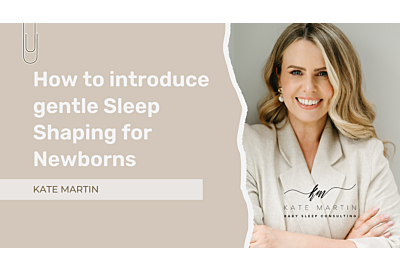How to introduce gentle Sleep Shaping for Newborns
In the early weeks and months, a newborn baby’s sleep is unpredictable and is determined mostly by their need to feed when hungry and sleep in between. The most important thing for you and your baby in the early days, weeks and months is to spend time together establishing a bond and enjoy all of the wonderful newborn snuggles this special time brings.
There is no right or wrong when it comes to newborn sleep. Some babies will do longer stretches of a few hours sleep, others will only do short ‘cat naps’. Some will sleep in a Moses basket or cot, others will only sleep cuddled up on their parent or carer. Some will sleep more during the day and be more awake at night or vice versa. None of these things mean you have a ‘bad sleeper’ - this is all perfectly normal for a newborn!
One of the most important things you can do for your baby at this stage is to help support their circadian rhythm by exposing them to lots of daylight and fresh air during the day and darkness at night so they learn to understand the difference between day and night which will support healthy sleep habits moving forward. So even if your baby is up late with you at night, ensure you dim lights and reduce noise levels etc so it is a more calming and relaxing environment to help them understand you are winding down and getting ready for sleep.
When you are feeling ready to do so, you can support this further by introducing a consistent wake up time for your baby. I recommend this from about 6 weeks onward and 7am or 730am is a good ‘wake up’ time to aim for. This can sometimes be tough after a challenging night but the more you can start to gradually introduce this the more it will help to regulate their body clock to understand it’s time for them to wake up and start the day. Take your time with this and go at your own pace.
As your baby continues to grow and develop, try to understand and learn about their sleep cues. If you are not familiar with sleep cues, these are signs your baby is showing you that they are ready to sleep.
They can include:
- Yawning
- Quietens
- Fluttering eyelids
- Difficulty to focus
- Sucks thumb, finger or dummy
- Rubbing eyes
Try to pay attention to and watch out for these signs and if you do notice them, it might be time to get your baby ready for a nap.
Do not ever be worried about how or where your baby sleeps during the newborn phase as long as you are adhering to safe sleeping guidelines (remember the safest place a baby can sleep for the first 6 months is in the same room as you). Things like contact naps are not ‘bad habits’ or if they need to be held, rocked or shushed to sleep please know this is perfectly normal.
When they are a little older and you are both ready to do so, they will be able to learn to sleep independently if you so wish, but for now, enjoy every minute of your newborn bubble and every precious cuddle!
For more Sleep Safety guidelines you can visit the Lullaby Trust here.
Kate Martin
Certified Sleep Practitioner & Baby Sleep Consultant
IG: @katemartin_sleepconsulting
www.katemartinsleepconsulting.com
If you are looking for some help or guidance with your baby’s sleep, Kate offers a FREE 15 minute Discovery Call which you can book here.
